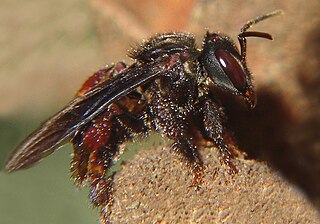
San Cono is a small village and comune in the Metropolitan City of Catania on the island of Sicily, southern Italy. It is an agricultural community, and is known particularly for its production of prickly pears.
Vulture bees, also known as carrion bees, are a small group of three closely related South American stingless bee species in the genus Trigona which feed on rotting meat. Some vulture bees produce a substance similar to royal jelly which is not derived from nectar, but rather from protein-rich secretions of the bees' hypopharyngeal glands. These secretions are likely derived from the bees' diet, which consists of carrion eaten outside the nest, and resulted in the belief that they produce what is known as “meat honey”. This unusual behavior was only discovered in 1982, nearly two centuries after the bees were first classified.

Trigona is one of the largest genera of stingless bees, comprising about 32 species, exclusively occurring in the New World, and formerly including many more subgenera than the present assemblage; many of these former subgenera have been elevated to generic status.

Bertholdia trigona, or Grote's bertholdia, is a species of moth in the family Erebidae. The species was first described by Augustus Radcliffe Grote in 1879. It is prevalent in the southwestern United States.

Trigona spinipes is a species of stingless bee. It occurs in Brazil, where it is called arapuá, aripuá, irapuá, japurá or abelha-cachorro ("dog-bee"). The species name means "spiny feet" in Latin. Trigona spinipes builds its nest on trees, out of mud, resin, wax, and assorted debris, including dung. Therefore, its honey is not fit for consumption, even though it is reputed to be of good quality by itself, and is used in folk medicine. Colonies may have from 5,000 to over 100,000 workers.

Euphorbia trigona, the African milk tree, cathedral cactus, or Abyssinian euphorbia, is a species of flowering plant that originates from Central Africa. Somewhat common in cultivation as a houseplant or as a hedge, the species is one of the euphorbias with succulent stems and branches as an adaptation to arid climates.
Compsosomatini is a tribe of longhorn beetles of the subfamily Lamiinae.

Aerenea is a genus of longhorn beetles of the subfamily Lamiinae.
Aerenea aglaia is a species of beetle in the family Cerambycidae. It was described by Monné in 1980. It is known from Brazil.
Aerenea occulta is a species of beetle in the family Cerambycidae. It was described by Monné in 1980. It is known from Argentina.
Aerenea sulcicollis is a species of beetle in the family Cerambycidae. It was described by Melzer in 1932.
Aerenea flavofasciculata is a species of beetle in the family Cerambycidae. It was described by Stephan von Breuning in 1948. It is known from Peru.
Aerenea ecuadoriensis is a species of beetle in the family Cerambycidae. It was described by Stephan von Breuning in 1947. It is known from Ecuador.
Aerenea periscelifera is a species of beetle in the family Cerambycidae. It was described by Thomson in 1868. It is known from Colombia and Brazil.
Aerenea setifera is a species of beetle in the family Cerambycidae. It was described by Thomson in 1868. It is known from Brazil.
Aerenea bimaculata is a species of beetle in the family Cerambycidae. It was described by Juan Brèthes in 1920. It is known from Peru and Bolivia.
Aerenea panamensis is a species of beetle in the family Cerambycidae. It was described by Martins and Galileo in 2010. It is known from Panama.

Aerenea quadriplagiata is a species of beetle in the family Cerambycidae. It was described by Carl Henrik Boheman in 1859. It is known from Argentina, Brazil, Bolivia, Paraguay, and Uruguay.

Trigona corvina is a species of stingless bee that lives primarily in Central and South America. In Panama, they are sometimes known as zagañas. They live in protective nests high in the trees, but they can be extremely aggressive and territorial over their resources. They use their pheromones to protect their food sources and to signal their location to nest mates. This black stingless bees of the tribe Meliponini can be parasitic toward citrus trees but also helpful for crop pollination.

Trigona fuscipennis is a stingless bee species that originates in Mexico but is also found in Central and South America. They are an advanced eusocial group of bees and play a key role as pollinators in wet rainforests. The species has many common names, including mapaitero, sanharó, abelha-brava, xnuk, k'uris-kab, enreda, corta-cabelo, currunchos, zagaño, and enredapelos.







